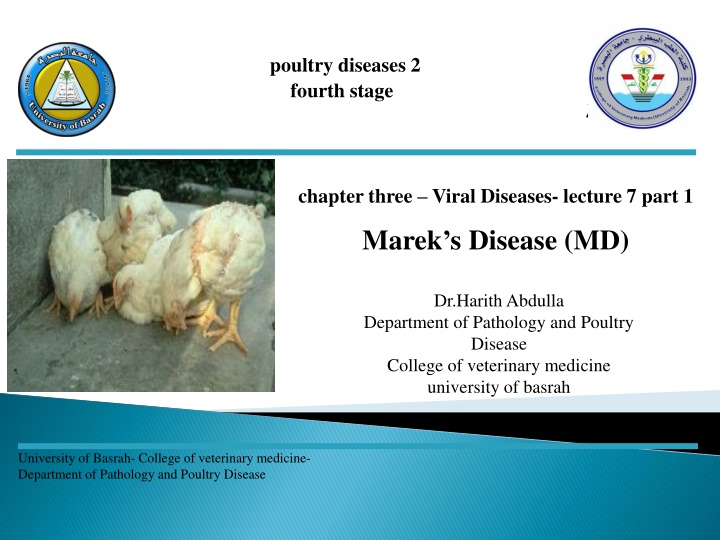
Marek's Disease (MD): Overview, Symptoms, and Prevention
Learn about Marek's Disease (MD) in chickens, a highly infectious viral disease characterized by paralysis and lymphoid tumors. Discover its etiology, spread, clinical signs, post-mortem lesions, and differential diagnosis. Find out how to diagnose and prevent Marek's Disease through vaccination and other measures.
Download Presentation

Please find below an Image/Link to download the presentation.
The content on the website is provided AS IS for your information and personal use only. It may not be sold, licensed, or shared on other websites without obtaining consent from the author. If you encounter any issues during the download, it is possible that the publisher has removed the file from their server.
You are allowed to download the files provided on this website for personal or commercial use, subject to the condition that they are used lawfully. All files are the property of their respective owners.
The content on the website is provided AS IS for your information and personal use only. It may not be sold, licensed, or shared on other websites without obtaining consent from the author.
E N D
Presentation Transcript
poultry diseases 2 fourth stage chapter three Viral Diseases- lecture 7 part 1 Marek s Disease (MD) Dr.HarithAbdulla Department of Pathology and Poultry Disease College of veterinary medicine university of basrah University of Basrah- College of veterinary medicine- Department of Pathology and Poultry Disease
Mareks Disease (MD) MD is a highly infectious disease of chickens characterized by paralysis of wings and legs and presence of lymphoid tumors in various organs,due to mononuclear cell infiltration in the peripheral nerves and various other organs and tissues including iris and skin. O Etiology Etiology :Group :Group of B Herpes virus . O Incubation period Incubation period : 4 12 weeks . O Course of disease Course of disease :- 10 12 weeks .
O Method of spread Method of spread :- 1. Feather follicles , dander , secretion and excretion . 2. Air currents . 3. Carriers . 4. Beetls , Alphitobius diaperinus . O Mortality Mortality :- Broilers 1 5 % . Layers 10 50 %. Breeder hens 5 25 % . O Forms of the disease Forms of the disease 1. Nervous form : Classical form . 2. Visceral form . 3. Eye form .(Ocular form) 4. Skin form .(Cutaneous form)
Clinical signs : 1.Asymmetric progressive paresis, later complete paralysis of one or more extremities. 2.Involvement of vagus nerve can result in paralysis and dilation of crop and /or gasping. 3.Incoordination or stilted gait may be the first sign. 4.Characteristic sign is one leg stretched forward and the other back due to unilateral paresis or paralysis of the leg(Fan shape posture). 5.Pupil becomes irregular in size . 6.Iris becomes gray in color . 7.Pale shriveled combs .
Post mortem lesions: 1.Feather follicles are enlarged . 2.Tumors in any tissue or organs .The lesions appear as diffuse enlargement in most organs, focal or nodular may be also observed. 3.Enlarged, edematous and loss of cross- striation of peripheral nerves.(Sciatic and brachial nerves). 4.Many birds may die without lesions due to viremia .
O Differential Differential Diagnosis : 1. Lymphoid leukosis . Riboflavin deficiency . 3. Histomoniasis( Black Head Disease). 4. Any disease causing nervous signs . ODiagnosis Diagnosis : : 1. Signs . Lesions. Histopathology . Viral isolation . O Prevention Prevention : :- - Vaccination. Diagnosis : 2. 2. 3. 4.
